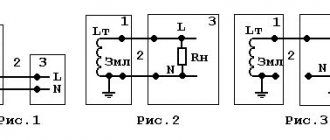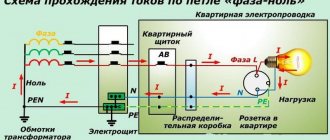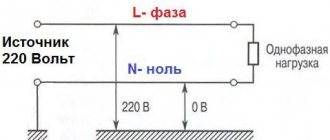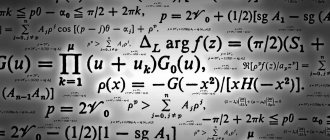Harmonic parameters
Any oscillatory process is a change in some parameter around the average value. Oscillations can be periodic (pendulum) or non-periodic (flag in the wind). If you build a graph of the oscillatory process, then the average value on it will be represented by a horizontal straight line, and the value of the oscillating parameter will be represented by a curve that constantly returns to the average. In this case, for a non-periodic oscillation the returns will be chaotic, and for a periodic oscillation - strictly after the same period of time. This interval is called the period of oscillation $T$.
Rice. 1. Periodic and non-periodic oscillations.
The simplest periodic oscillation is an oscillation that occurs according to the law of circular functions (sine or cosine). It is called harmonic. Since in higher mathematics it is proven that any oscillation (including non-periodic) can be represented in terms of an infinite sum of harmonic oscillations, then they are studied first of all. And by definition, any harmonic oscillation can be represented as a function:
$$A=A_0sin \Bigg ( {2\pi\over T} t +\varphi_0 \Bigg ),$$
Where:
- $A_0$ is the oscillation amplitude, the maximum deviation of the instantaneous value of the function from zero;
- $T$ is the period of oscillation;
- $t$ is a free variable—the moment of time for which the instantaneous amplitude value is found;
- $\varphi_0$ is the initial phase of oscillations.
The coefficient ${2\pi\over T}=\omega$ for the free variable $t$ is called the angular frequency. Its physical meaning is that it is the angle traversed by a harmonic function per unit time. The value of the expression ${2\pi\over T} t +\varphi_0=\varphi$, which is the argument of the sine function, is called the total phase of the oscillation.
Rice. 2. Oscillation phase.
§ 23. Oscillation phase
Chapter 3. Mechanical vibrationsLet us introduce another quantity characterizing harmonic oscillations - the phase of oscillations
.
For a given amplitude of oscillations, the coordinate of the oscillating body at any time is uniquely determined by the argument of the cosine or sine: φ = ω0t.
The value φ, standing under the sign of the cosine or sine function, is called the oscillation phase described by this function. The phase is expressed in angular units - radians.
The phase determines not only the value of the coordinate, but also the value of other physical quantities, such as speed and acceleration, which also vary according to a harmonic law. Therefore, we can say that the phase determines, for a given amplitude, the state of the oscillatory system at any time
. This is the meaning of the concept of phase.
Oscillations with the same amplitudes and frequencies may differ in phase.
Since then
The ratio indicates how many periods have passed since the start of the oscillation. Any time value t, expressed in the number of periods T, corresponds to the phase value φ, expressed in radians. So, after time (a quarter of a period), after half a period, φ = π, after a whole period, φ = 2π, etc.
You can depict on a graph the dependence of the coordinates of an oscillating point not on time, but on phase. Figure 3.7 shows the same cosine wave as in Figure 3.6, but different phase values φ are plotted on the horizontal axis instead of time.
Representation of harmonic vibrations using cosine and sine. You already know that during harmonic vibrations the coordinate of a body changes over time according to the law of cosine or sine. After introducing the concept of phase, we will dwell on this in more detail.
The sine differs from the cosine by shifting the argument by , which corresponds, as can be seen from equation (3.21), to a time period equal to a quarter of the period:
Therefore, instead of the formula x = xm cos ω0t, we can use the formula to describe harmonic oscillations
But at the same time the initial phase
, i.e. the phase value at time t = 0, is not equal to zero, but .
Usually we excite oscillations of a body attached to a spring, or oscillations of a pendulum, by removing the body of the pendulum from its equilibrium position and then releasing it. The displacement from the equilibrium position is maximum at the initial moment. Therefore, to describe oscillations, it is more convenient to use formula (3.14) using a cosine than formula (3.23) using a sine.
But if we excited oscillations of a body at rest with a short-term push, then the coordinate of the body at the initial moment would be equal to zero, and it would be more convenient to describe changes in the coordinate over time using the sine, i.e., by the formula
x = xm sin ω0t, (3.24)
since in this case the initial phase is zero.
If at the initial moment of time (at t - 0) the phase of oscillations is equal to φ, then the equation of oscillations can be written in the form
x = xm sin (ω0t + φ).
Phase shift. The oscillations described by formulas (3.23) and (3.24) differ from each other only in phases. The phase difference, or, as is often said, the phase shift of these oscillations is . Figure 3.8 shows graphs of coordinates versus time for two harmonic oscillations shifted in phase by . Graph 1 corresponds to oscillations that occur according to the sinusoidal law: x = xm sin ω0t, and graph 2 corresponds to oscillations that occur according to the cosine law:
To determine the phase difference between two oscillations, in both cases the oscillating quantity must be expressed through the same trigonometric function - cosine or sine.
Questions for the paragraph
1. What vibrations are called harmonic?
2. How are acceleration and coordinate related in harmonic vibrations?
3. How are the cyclic frequency of oscillations and the period of oscillation related?
4. Why does the frequency of oscillation of a body attached to a spring depend on its mass, but the frequency of oscillation of a mathematical pendulum does not depend on mass?
5. What are the amplitudes and periods of three different harmonic oscillations, the graphs of which are presented in Figures 3.8, 3.9?
Harmonic phase
From the formula of harmonic oscillation one can understand the physical meaning of the phase. Since the argument of the function $sin(x)$ is the angle of rotation of the unit vector on the coordinate plane, expressed in radians, and its period is equal to $2\pi$, then the phase is the part of the oscillation period corresponding to the moment $t$. It is also expressed in radians and also has a period of $2\pi$.
From the formula you can also see that if $t=0$, then $\varphi=\varphi_0$ (the total phase at the initial moment is equal to the initial phase).
Vector diagram method
Harmonic oscillations can be represented graphically (vector diagram method). To do this, from an arbitrarily chosen point O on the X axis at an angle equal to the initial phase ($\varphi )$, the vector $\overline{A}$ is plotted. The modulus of which is equal to the amplitude ($A$) of oscillations. If this vector is rotated with angular velocity ${\omega }_0$, then the projection of the end of this vector moves along the X axis and takes values from $-A$ to $A$. The law of oscillations will be equation (1).
And so, harmonic oscillations can be depicted using a projection onto a certain axis of the amplitude vector $\overline{A}$, which is plotted from an arbitrary point of this axis at an angle $\varphi $, rotating with an angular velocity ${\omega }_0$ around the chosen points.
Phase difference
For one oscillatory process, the phase does not play a big role. In fact, if we take different moments of time as initial ones, we can obtain any phase value, and the oscillatory process will not change in any way. However, when we are talking about several oscillatory processes, the phase value increases significantly. It is the phase that determines the difference in the instantaneous values of the two oscillations.
Rice. 3. Graphs of oscillations with different phases.
If the oscillation frequencies are not the same, then at each moment of time the phases will be different, their difference will also change. If the oscillation frequencies are the same, then despite the change in the phase of each oscillation over time, the phase difference between these two oscillations will be constant. This can lead to interesting situations.
For example, if we take two oscillations with the same amplitudes and frequencies, but the first has an initial phase equal to zero, and the second has $\pi$, then these two oscillations will never have the same non-zero values. Moreover, if these fluctuations are added, their sum will always be zero. They say that such processes occur in antiphase.
Phase - harmonic oscillation - Great Encyclopedia of Oil and Gas, article, page 1
Phase - harmonic oscillation
Page 1
The phase of a harmonic oscillation determines the value of the changing quantity at a given time. [2]
The phase of a harmonic oscillation determines the value of the changing quantity (along with the amplitude) at a given time. [4]
The phase of a harmonic oscillation determines the value of a changing quantity with a unit amplitude at a given time. [5]
The phase difference of a harmonic oscillation changes cyclically, and its direct measurement is possible only within one phase cycle. Therefore, to determine the total signal propagation time from the measured phase difference, it is necessary to measure the oscillation phase differences at several known modulation frequencies, or, by smoothly changing the modulation frequency, determine the number of complete phase cycles corresponding to a certain continuous range of their changes and the frequency limiting the selected range. [6]
The constant φ is called the phase of the harmonic oscillation, or more precisely, the initial phase. This value is expressed in fractions of a radian. With an arbitrary but fixed choice of the start of time counting, different oscillations of the same frequency can have different phases. [7]
By what amount does the phase of harmonic oscillations change in one period and in one second? [8]
What determines the frequency, amplitude and phase of harmonic oscillations. [9]
In various radio engineering devices there is a need to measure the phase of harmonic oscillations. [10]
These converters use devices that make it possible to obtain a phase shift of a harmonic oscillation that is proportional to the angle of rotation of the input axis of this device. The phase shift between the reference harmonic oscillation and the oscillation at the output of the device can be represented by electronic zero extraction circuits as two pulses, and the time interval between the two pulses is converted into digital form using the circuits already described. A block diagram of such a converter is shown in Fig. [eleven]
The relationship between the real and imaginary parts of the frequency response determines the phase shift of the harmonic oscillation at frequency co. [12]
The phase frequency characteristic [( φ) is the dependence of the change in the phase of the output harmonic oscillation in relation to the phase of the input oscillation on frequency. [13]
Composite signals are generated by manipulating the amplitude, frequency, or phase of a harmonic subcarrier with a coded sequence of video pulses. [14]
Frequency characteristics are functions of frequency o that describe changes in the amplitude and phase of harmonic oscillations passing through a linear element. [15]
Pages: 1 2 3
www.ngpedia.ru
The concept of the phase of the oscillatory process
Any oscillatory process can be represented as an infinite sum of simple harmonic oscillations. Harmonic oscillation is an oscillation that occurs according to the law of circular functions (sine or cosine).
Rice. 1. Graph of the harmonic function.
The formula for harmonic vibration is as follows:
$$X = X_m sin(\omega t+\varphi)$$
Where:
- $t$ is the current moment in time;
- $X$ is the current value of the parameter;
- $X_m$ is the amplitude (maximum) value of the parameter;
- $\omega$ — frequency;
- $\varphi$ is the initial phase.
From the presented formula you can see that as the value of time $t$ changes, the argument of the circular function constantly increases. This argument $(\omega t+\varphi)$ is called phase. The unit of phase is the radian, and since the circular function has a period of $2\pi$, the phase is generally considered only in the range from zero to $2\pi$.
Rice. 2. Oscillation phase.
The formula also shows that the phase is a linear function of time, which increases monotonically with the value of $\varphi$. Therefore this value is called the initial phase.
Energy conversion during harmonic oscillations
To describe energy transformations during harmonic oscillations, we agree that we will neglect the friction force. For a description, refer to the figure below.
Point O in the figure corresponds to the equilibrium position of the ball. If it is pulled back to a distance xmax equal to the amplitude, the spring will receive potential energy, which in this position will take a maximum value equal to:
Wp max=kx2max2..
When the ball is released, an elastic force arises, under the influence of which the ball rushes to the left. As the distance between the point of maximum deflection and the equilibrium position decreases, the potential energy decreases. But at this time the kinetic energy of the ball increases. When the ball passes through the equilibrium position for the first time, its potential energy becomes zero, and its kinetic energy reaches its maximum value (the speed at this point in time is also maximum):
Wk max=mv2max2..
After passing point O, the distance between the ball and the equilibrium position increases again, and the potential energy increases. At the same time, the kinetic energy decreases. And in the extreme position on the left it becomes equal to zero, while the potential energy again takes on its maximum value.
Since we agreed to neglect friction, this oscillatory system can be considered isolated. Then it must comply with the law of conservation of energy. According to it, the total mechanical energy of the system is equal to:
W=Wp+Wk=kx2x2..+mv2x2..=kx2max2..=mv2max2..
In reality, free oscillations always dampen, since the friction force acts in the oscillatory system. And part of the mechanical energy is dissipated in the form of heat. An example of a graph of damped oscillations looks like this:
Example No. 2. A mass attached to a spring oscillates on a horizontal smooth rod. Find the ratio of the kinetic energy of the load to its potential energy of the system at the moment when the load is at a point located midway between the extreme position and the equilibrium position.
Since the load is located midway between the extreme position and the equilibrium position, its coordinate is equal to half the amplitude:
x=xmax2..
At this time, the potential energy of the load will be equal to:
Wp=kx22..=k(xmax2..)22..=kx2max8..
According to the law of conservation of energy, kinetic energy at this time is equal to:
Wk=W−Wp
The total mechanical energy of the system is equal to the maximum potential energy:
W=Wp max=kx2max2..
Then the kinetic energy is equal to:
Wk=kx2max2..−kx2max8..
Therefore, the ratio of kinetic energy to potential energy will look like this:
WkWp..=kx2max2..−kx2max8..kx2max8….=kx2max2..8kx2max..−1=4−1=3
Period and frequency of harmonic oscillations
The minimum period of time T, through which the movement of the body is completely repeated, is called the period of oscillation. Knowing it, you can calculate the oscillation frequency, equal to the number of oscillations per unit time. These quantities are related to each other by the expression:
ν=1T..
After a time interval equal to the period T and corresponding to a change in the argument of the cosine by ω0T, the movement of the body is repeated, and the cosine takes on its previous value. But from mathematics it is known that the smallest period of the cosine is 2π. Hence:
ω0T=2π
From here:
ω0=2πT..=2πν
Thus, the value ω0 represents the number of vibrations of the body, but not in 1 second, but in 2π seconds. This quantity is called cyclic (circular) frequency . And the frequency of free vibrations is called the natural frequency of the oscillatory system .










